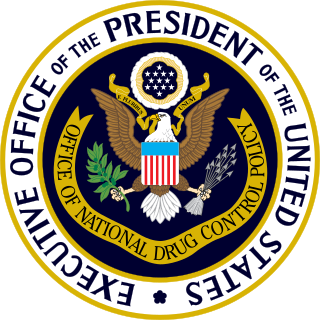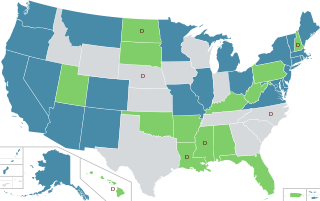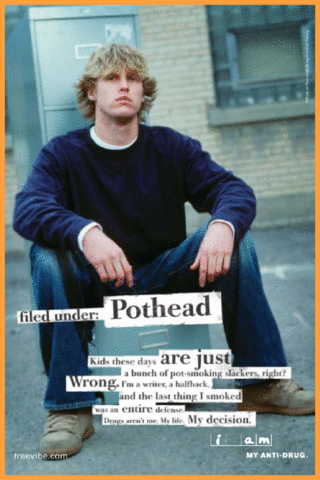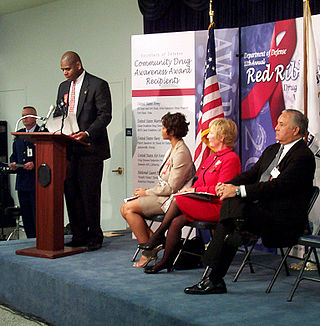Related Research Articles

The Office of National Drug Control Policy (ONDCP) is a component of the Executive Office of the President of the United States.
Drug czar is an informal name for the person who directs drug-control policies in various areas. The term follows the informal use of the term czar in U.S. politics. The 'drug czar' title first appeared in a 1982 news story by United Press International that reported that, "[United States] Senators ... voted 62–34 to establish a 'drug czar' who would have overall responsibility for U.S. drug policy." Since then, several ad hoc executive positions established in both the United States and United Kingdom have subsequently been referred to in this manner.

The war on drugs is a global campaign, led by the United States federal government, of drug prohibition, military aid, and military intervention, with the aim of reducing the illegal drug trade in the United States. The initiative includes a set of drug policies that are intended to discourage the production, distribution, and consumption of psychoactive drugs that the participating governments and the United Nations have made illegal. The term was popularized by the media shortly after a press conference given on June 18, 1971, by President Richard Nixon – the day after publication of a special message from President Nixon to the Congress on Drug Abuse Prevention and Control – during which he declared drug abuse "public enemy number one". That message to the Congress included text about devoting more federal resources to the "prevention of new addicts, and the rehabilitation of those who are addicted" but that part did not receive the same public attention as the term "war on drugs". Two years prior to this, Nixon had formally declared a "war on drugs" that would be directed toward eradication, interdiction, and incarceration. In 2015, the Drug Policy Alliance, which advocates for an end to the War on Drugs, estimated that the United States spends $51 billion annually on these initiatives, and in 2021, after 50 years of the drug war, others have estimated that the US has spent a cumulative $1 trillion on it.
This article is intended to provide an overview of several commonly cited arguments for and against the prohibition of drugs.

The National Institute on Drug Abuse (NIDA) is a United States federal government research institute whose mission is to "advance science on the causes and consequences of drug use and addiction and to apply that knowledge to improve individual and public health."
Truth is a national campaign aimed at eliminating teen smoking in the United States. truth produces television and digital content to encourage teens to reject tobacco and to unite against the tobacco industry. When truth launched its campaign in 1998, the teen smoking rate was 23%. In 2018, tobacco products were used by 7.2% of middle schoolers and 27.1% of high schoolers. In August 2014, truth launched "Finish It", a redesigned campaign encouraging youth to be the generation that ends smoking.

The Montana Meth Project (MMP) is a Montana-based non-profit organization founded by businessman Thomas Siebel which seeks to reduce methamphetamine use, particularly among teenagers. The main venture of the MMP is a saturation-level advertising campaign of television, radio, print, and Internet ads that graphically depict the negative consequences of methamphetamine use. Common elements are the deterioration of each teenage subject's health and living conditions, amphetamine psychosis, moral compromise, and regret. As of 2010, the Meth Project has expanded its media campaign into seven additional states. As of March 13, 2013 the Meth Project, the umbrella organization of the Montana Meth Project, joined the Partnership for Drug-Free Kids in their efforts to reduce substance abuse among teens.

In the United States, the non-medical use of cannabis is legalized in 23 states and decriminalized in 8 states, as of May 2023. Decriminalization refers to a policy of reduced penalties for cannabis offenses, typically involving a civil penalty for possessing small amounts, instead of criminal prosecution or the threat of arrest. In jurisdictions without penalty the policy is referred to as legalization, although the term decriminalization is sometimes used for this purpose as well.
The Drug Resistance Strategies Project (DRS), a program funded by the National Institute on Drug Abuse (NIDA), teaches adolescents and pre-adolescents how to make decisions and resist alcohol, tobacco, and other drugs (ATOD).

Substance abuse prevention, also known as drug abuse prevention, is a process that attempts to prevent the onset of substance use or limit the development of problems associated with using psychoactive substances. Prevention efforts may focus on the individual or their surroundings. A concept that is known as "environmental prevention" focuses on changing community conditions or policies so that the availability of substances is reduced as well as the demand. Individual Substance Abuse Prevention, also known as drug abuse prevention involves numerous different sessions depending on the individual to help cease or reduce the use of substances. The time period to help a specific individual can vary based upon many aspects of an individual. The type of Prevention efforts should be based upon the individual's necessities which can also vary. Substance use prevention efforts typically focus on minors and young adults – especially between 12–35 years of age. Substances typically targeted by preventive efforts include alcohol, tobacco, marijuana, inhalants, coke, methamphetamine, steroids, club drugs, and opioids. Community advocacy against substance use is imperative due to the significant increase in opioid overdoses in the United States alone. It has been estimated that about one hundred and thirty individuals continue to lose their lives daily due to opioid overdoses alone.

The Think Before You Speak campaign is a television, radio, and magazine advertising campaign launched in 2008 and developed to raise awareness of the common use of derogatory vocabulary among youth towards lesbian, gay, bisexual, transgender, queer/questioning (LGBTQ) people. It also aims to "raise awareness about the prevalence and consequences of anti-LGBTQ bias and behaviour in America's schools." As LGBTQ people have become more accepted in the mainstream culture more studies have confirmed that they are one of the most targeted groups for harassment and bullying. An "analysis of 14 years of hate crime data" by the FBI found that gays and lesbians, or those perceived to be gay, "are far more likely to be victims of a violent hate crime than any other minority group in the United States". "As Americans become more accepting of LGBT people, the most extreme elements of the anti-gay movement are digging in their heels and continuing to defame gays and lesbians with falsehoods that grow more incendiary by the day," said Mark Potok, editor of the Intelligence Report. "The leaders of this movement may deny it, but it seems clear that their demonization of gays and lesbians plays a role in fomenting the violence, hatred and bullying we're seeing." Because of their sexual orientation or gender identity/expression, nearly half of LGBTQ students have been physically assaulted at school. The campaign takes positive steps to counteract hateful and anti-gay speech that LGBTQ students experience in their daily lives in hopes to de-escalate the cycle of hate speech/harassment/bullying/physical threats and violence.

Cannabis use disorder (CUD), also known as cannabis addiction or marijuana addiction, is defined in the fifth revision of the Diagnostic and Statistical Manual of Mental Disorders (DSM-5) and ICD-10 as the continued use of cannabis despite clinically significant impairment.

The National Youth Anti-Drug Media Campaign is a current domestic government propaganda campaign in the United States conducted by the Office of National Drug Control Policy (ONDCP) within the Executive Office of the President of the United States with the goal to "influence the attitudes of the public and the news media with respect to drug abuse" and of "reducing and preventing drug abuse among young people in the United States".

Partnership to End Addiction, first known as the Partnership for a Drug-Free America (PDFA) then later as the Partnership at DrugFree.org, and The Partnership for Drug-Free Kids, is a New York City-based non-profit organization which runs campaigns to prevent teenage drug and alcohol use in the United States. It is notable for mobilizing volunteer talent "against a single social problem" to help young people "live their lives free of drug and alcohol abuse," and to assist parents in prevention efforts. The organization gets input from scientists, specialists in communication, researchers and others, and offers resources for parents and teenagers on its website. It focused efforts to "unsell" illegal drugs such as cocaine, heroin, prescription drugs, marijuana, MDMA, and others, as well as discouraging the use of alcohol and nitrous oxide, by breaking away from a standard public service approach and doing a coordinated media campaign. While the organization has focused drug prevention advertising on broadcast media such as television, there are signs in recent years that it is shifting media support to emerging channels such as video-on-demand, digital technology and particularly the Internet. The organization's marketing experience was written up as a 58-page marketing "case study" for study by students at the Harvard Business School. The organization is perhaps best known for its iconic TV ad This Is Your Brain on Drugs, but it had made over 3,000 ads by 2011 while pursuing a flexible strategy.

Michael P. Botticelli is an American public health official who served as the director of the White House Office of National Drug Control Policy (ONDCP) from March 2014 until the end of President Obama's term. He was named acting director after the resignation of Gil Kerlikowske, and received confirmation from the United States Senate in February 2015. Prior to joining ONDCP, he worked in the Massachusetts Department of Public Health. Following completion of his service as ONDCP Director, he became the executive director of the Grayken Center for Addiction Medicine at the Boston Medical Center.
The cannabis policy of the Reagan administration involved affirmation of the War on Drugs, government funded anti-cannabis media campaigns, expanded funding for law enforcement, involvement of the U.S. military in interdiction and eradication, reduction in emphasis in drug treatment, and creation of new Federal powers to test employees and seize cannabis-related assets.
"Note from Mom" and "Rough Night" are anti-cannabis public service announcements created by the United States Office of National Drug Control Policy (ONDCP). The spoken slogan is "Get tough, get creative, just get through" and is presented with a written slogan "Action: the anti-drug" and URL, theantidrug.com, and an ONDCP toll-free telephone number. The ads, targeted at parents, were found by a research study to be relatively ineffective in influencing teenagers' behavior.
"Nothing Happens", also called "Nothing can happen to you, too", or "Marijuana can make nothing happen to you, too", was an anti-cannabis public service announcement created by the United States Office of National Drug Control Policy (ONDCP).
"Dog's View", also called "Talking Dog", is a 2007 anti-cannabis public service announcement (PSA) created by the United States Office of National Drug Control Policy (ONDCP) as part of the Above the Influence campaign. The PSA features a dog who sits down at a kitchen counter and asks a teenage girl if she might be smoking too much marijuana. It was one of several ONDCP PSAs shown to increase cannabis consumption in teens. It has been the subject of numerous parodies and critiques, including a Joe Rogan stand-up routine, and a 2008 parody featuring Aubrey Plaza who resembles the actress in the original. The original PSA acquired over 1.1 million views on YouTube between its upload in 2008 and 2017. In 2011, Adweek profiled the PSA as one of ten that "make you want to take drugs". In 2018, it was ranked by High Times as one of the top six worst anti-cannabis ads, "hilariously inaccurate".
References
- ↑ "About". Above the Influence.
- ↑ "21 USC Secs. 1501, 1502". Office of the Law Revision Counsel, U.S. House of Representatives. 2011-01-07. Archived from the original on 2012-03-17. Retrieved 2011-01-28.
{{cite web}}: CS1 maint: unfit URL (link) - ↑ "Contractor's National Evaluation Did Not Find That the Youth Anti-Drug Media Campaign Was Effective in Reducing Youth Drug Use" (PDF). United States Government Accountability Office. August 2006. p. 10.
- ↑ "National Anti-Drug Campaign Succeeds in Lowering Marijuana Use, Study Suggests". The Ohio State University Research News. Archived from the original on 2011-06-23. Retrieved 2011-02-22.
{{cite web}}: CS1 maint: unfit URL (link)